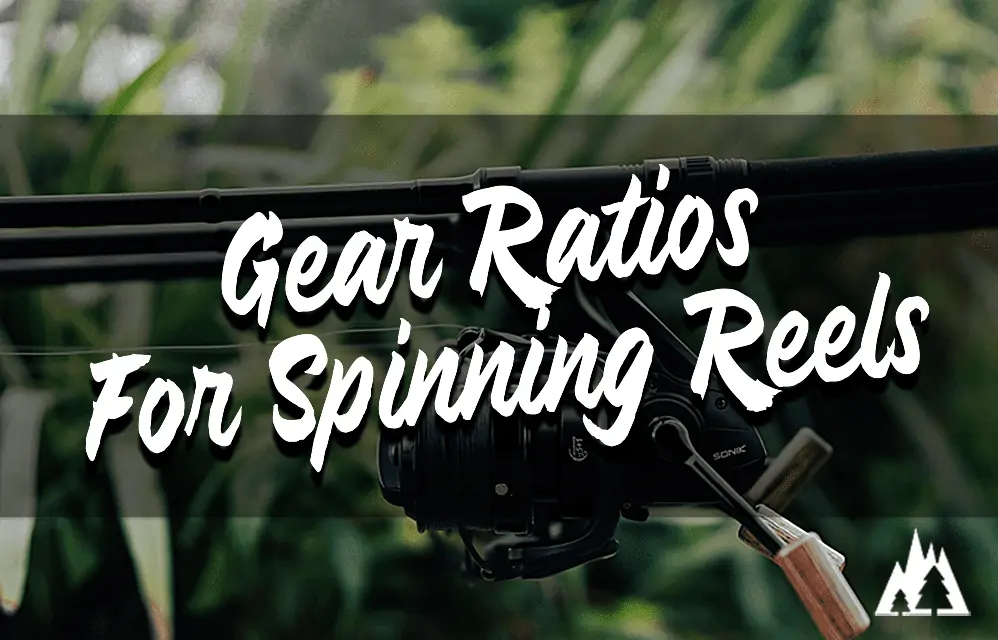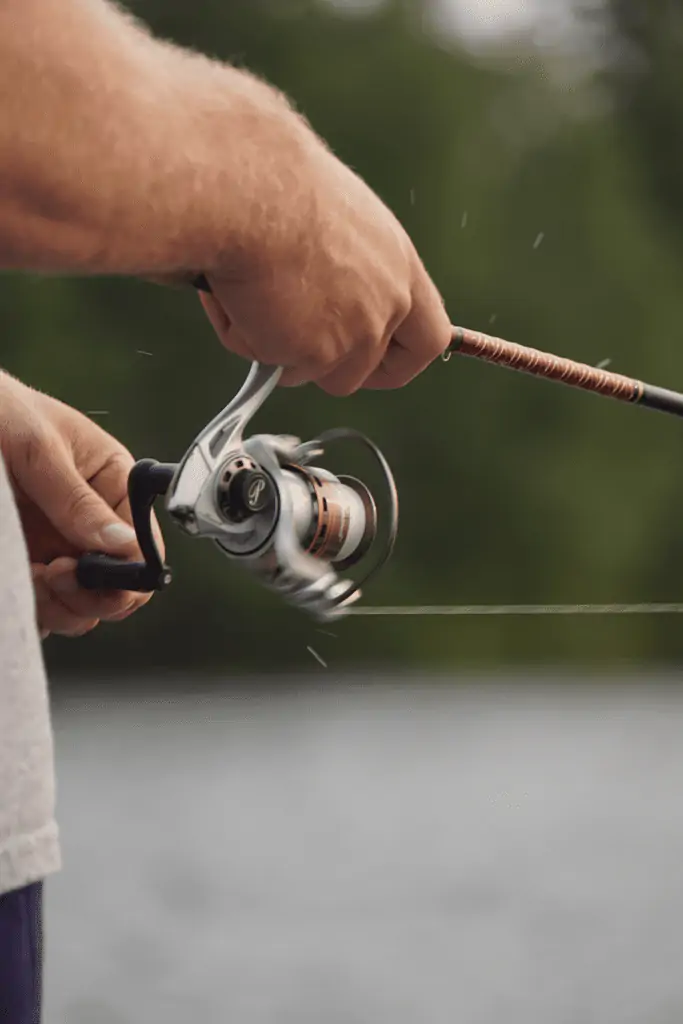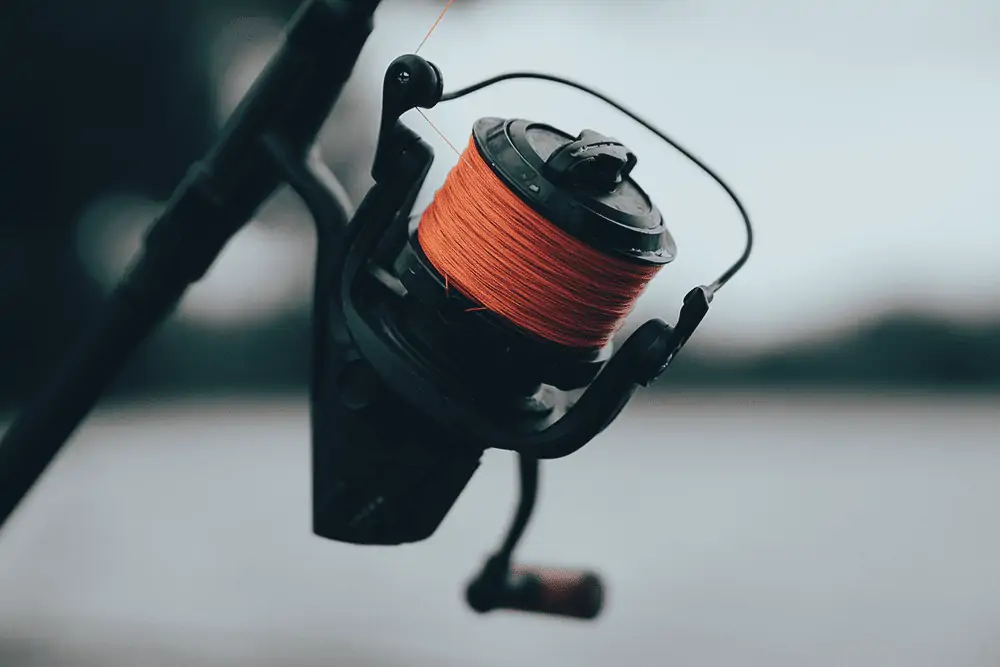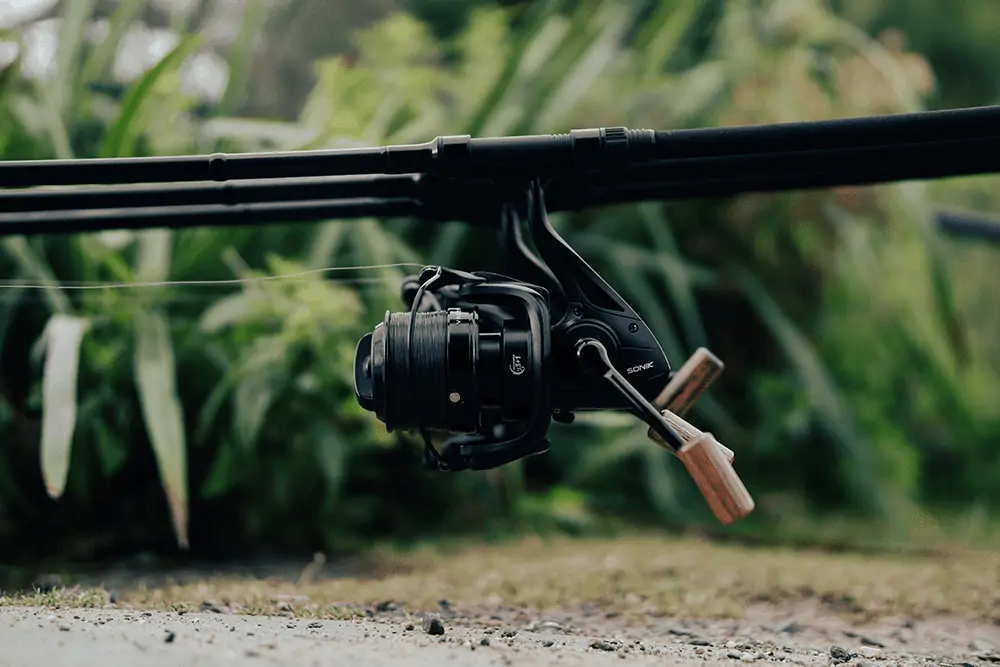What Is The Best Gear Ratio For Spinning Reels? And Why You’re Not Catching Fish

So what is the best gear ratio for spinning reels? If you’re new to fishing, this might all seem foreign to you.
Stick around. It’s simple to understand and learn when it matters (and when it doesn’t).
In fact, the first few years when I got into fishing, I really didn’t pay much attention to it.
Why? I was the typical “bait and wait” angler like most kids.
My parents would take me fishing using chopped-up baits or nightcrawlers.
I would bait my hook, cast out in the water, then wait for a bite.
As I got older, my skills and knowledge advanced me into learning more about the mechanics of a spinning reel and why they matter.
With that said…

What Is The Best Gear Ratio For Spinning Reels?
Ok, here’s my opinion on the matter, and I’ll explain things in more detail below.
For most anglers, the best gear ratio for spinning reels will be either a 5:1 or a 6:1 ratio. This simply means that for every complete turn of the handle, the spool will spin around 5 times (for a 5:1 ratio) or 6 times (for a 6:1 ratio).
However, the same gear ratio on two different brand spinning reels doesn’t necessarily mean they retrieve at the same speed. This is when figuring out the IPT (inches per turn) is more important (I’ll explain more below).
Let’s take a step back a bit first…
Here’s why someone might choose these gear ratios over the other:
- If you have a problem slowing down on the retrieve and tend to catch larger fish, I recommend a lower 5:1 gear ratio.
- If you’re looking for a more all-around gear ratio and want to get your line back in faster, I recommend a mid 6:1 gear ratio.
The smaller the gear ratio, the more torque you’ll have to reel in bigger fish. The larger the gear ratio, the faster you can retrieve certain lures for better performance.
If you’re a bait-and-wait angler, I personally don’t think it matters much. Gear ratios are more for having the right lure presentation.
For example, if you have a large bill crankbait using a high gear ratio will use a lot of energy to retrieve, not to mention the unnatural wobble in terms of presentation. Instead, using a lower gear ratio for crankbaits will entice more bites, and you won’t tire out easily.
Another example, some anglers want to cover as much area as possible to find the honey hole of fish. A drop shot rig that requires little retrieve will be more beneficial on higher-geared spinning reels because it’s a coverage game.
You cast out, and slowly twitch your reel a little. If there is no bite, you quickly reel in your line and cover another area.

Gear Ratio Is Just A Number – Here’s What To Really Look For
The actual gear ratio number is just that. A number.
It really doesn’t tell you how much line each full turn of the handle is retrieving.
Also, a 5:1 Shimano reel and a 5:1 Daiwa reel might not retrieve the same amount of line on a full turn of the handle.
So how do you figure out how much line is being retrieved?
By the IPT Calculation.
IPT stands for Inches Per Turn, and the calculation is simple:
IPT = Spool circumference (inches) X Gear Ratio
So let’s say your reel’s gear ratio is 6:1, and your spool circumference is 1.6″.
For every full turn of the handle, you will retrieve 9.6″ of line (6 multiplied by 1.6)
So a larger spool size means you’ll retrieve more line per full turn.
Ok cool, so why is this important?
Depending on how you fish, the right gear is essential for catching more fish.
Many anglers (including me) retrieve lures too fast, impeding their success in catching fish.
I can’t tell you how many times I really slowed down my retrieve and started to get bites.
But how do you know which will work best for your needs?
One of the most important decisions you’ll have to make when selecting a spinning reel is what kind of gear ratio works best.
Whether you want low-speed torque or higher line retrieval rates, there are several factors to consider before purchasing.
I’ll dive into low, medium, and high-gear ratios and provide tips on choosing the perfect fit for your needs.
Low Gear Ratio
A low gear ratio refers to the number of times the spool turns for every full turn of the handle.
For example, a low gear ratio, such as 4:1 or 5:1, means that the spool will turn four or five times for each full rotation of the handle. This gives anglers more control over their line and lures while casting and retrieving them from the water.
One advantage of using a low gear ratio is increased torque, allowing anglers to set hooks quickly and efficiently without applying too much pressure on their lines.
Another benefit of using a low gear ratio is that it helps reduce fatigue by allowing anglers to cast longer distances without tiring out as quickly as they would with higher ratios.
This type of gearing can be beneficial for those just starting out in fishing since it makes learning how to cast easier due to its slower speed.
Finally, many experienced fishermen prefer using low-gear reels because they offer greater sensitivity when detecting bites from fish below the surface level. This is largely due to its ability to generate more power at lower speeds than higher-geared models when retrieving heavier loads off bottom structures such as rocks or logs. All these advantages make low-gear reels ideal choices for those looking to increase their success rate while out on the water.
Low gear ratios are great for slow, steady retrieves and provide more torque when fighting larger fish.
Medium Gear Ratio
A medium gear ratio reel offers several advantages for anglers looking for increased speed and accuracy when casting. This reel has a higher retrieval rate than low-gear models, allowing you to cover more water quickly.
The medium gear ratio typically ranges from 5:1 up to 6:1, meaning that the spool will turn five or six times with each crank of the handle.
This makes it easier and faster to retrieve lures or bait while retrieving faster when casting long distances.
The higher gear ratio allows you to cast further out into deeper waters where bigger fish are likely hiding, giving you an edge over other anglers who may be using lower-geared reels.
Medium-geared reels are ideal for experienced anglers who want maximum control over their casts and retrieves without sacrificing speed or power output while targeting large gamefish such as bass, pike, musky, and walleye in deep water environments like lakes and rivers.
They can also be used effectively for trolling applications since they provide enough torque at slow speeds so that baits stay close behind the boat without getting tangled up in weeds or debris along shorelines.
Finally, many modern medium gearing reels feature adjustable drag systems, which allow you to adjust tension levels depending on the lure/bait combination you’re using and how hard fighting your catch might be once hooked onto your line. This makes them even more versatile tools for any serious fisherman’s tackle box.
Medium gear ratio reels are a great choice for those who want to cast further and retrieve their line quickly. High-gear ratio reels offer an ideal solution for anglers looking for even more speed.
High Gear Ratio
High gear ratios can benefit anglers looking to cast farther distances and get their lures in the depths of the strike zone or target faster-moving fish species. A higher gear ratio means it takes fewer turns of the handle for the spool to rotate once, resulting in increased speed when retrieving the line from your reel. This allows you to quickly move bait or lures through the water at greater speeds than lower-geared reels would allow.
And because they take less effort on behalf of the angler, high geared reels can help reduce fatigue over long days spent out on the water fishing.
When selecting a reel with a high gear ratio, it is important to consider what type of fishing you will primarily be doing before making your purchase decision, as not all applications may benefit from this feature set.
For example, if you plan on using light tackle, then opting for a low or medium-geared reel might suit your needs better since these models tend to have slower retrieve rates which can help prevent overworking lighter lines during retrieves and casts alike.
On the other hand, if you plan on using heavier tackle, then going with a higher-geared model could prove advantageous since it will allow access to greater amounts of power while still maintaining control over your lure or bait presentation throughout each cast without having to worry about losing control due excessive backlash caused by too much line being retrieved too quickly off the spool.
High-gear ratio spinning reels are great for those looking to increase their line retrieval speed, but choosing the right gear ratio for your needs is important.

Final Thoughts
Choosing the right gear ratio for your spinning reel is an important decision that can make a big difference in your fishing experience. It’s important to consider what type of fish you are targeting and the size and weight of lures or baits you plan on using. A higher gear ratio will provide more power and speed when retrieving lures, while a lower gear ratio will give you better control over lighter baits.
You can always slow your retrieve on a high-gear reel, and crank your retrieve on a low-gear reel.
When selecting a spinning reel with the appropriate gear ratio, it’s best to start by considering the fish species you intend to target.
For example, if bass fishing is your primary focus, then a medium-high or high-speed reel would be ideal for quickly retrieving crankbaits and other fast-moving lures. On the other hand, if trout fishing is your main goal, then something with a low-medium or slow speed would be better suited since they require slower retrieves when using light tackle such as jigs and spinners.
It’s also important to consider line capacity when choosing between different models of reels with varying gear ratios. Generally speaking, higher-speed reels have less line capacity than their slower counterparts. This should be considered depending on how many lines you need for specific techniques or situations like deep water trolling where extra line might be necessary.
Finally, it is always good practice to test out several different types of reels before making any purchase decisions so that you can get an idea of which one feels most comfortable in your hands and provides optimal performance based on personal preference rather than just relying solely on technical specifications alone. With research and experimentation, anglers can find the perfect combination of features that suits their needs without breaking the bank.
FAQs
What is a good ratio for a spinning reel?
The ideal ratio for a spinning reel depends on the type of fishing you are doing.
Generally, higher ratios (5:1 or 6:1) provide more power and speed when retrieving lures, while lower ratios (4:1 or less) are better suited for slow trolling or jigging. For most general-purpose applications, a 6:1 ratio is recommended as it provides an optimal balance between power and speed.
Consider the size of your line when selecting a reel; heavier lines require higher gear ratios to ensure adequate winding power.
What is a 5.2:1 gear ratio good for?
A 5.2:1 gear ratio is ideal for anglers who want to retrieve their bait or lure quickly and efficiently.
This ratio allows for a faster line retrieval rate, making it easier to cover more water in less time. It also provides the power needed to easily pull large fish out of heavy cover or deep water.
The higher speed of the reel makes it an excellent choice for trolling, jigging, and other techniques that require fast retrieves.
What is a 7.5:1 gear ratio good for?
A 7.5:1 gear ratio is great for applications that require a lot of speed and power, such as fishing lures or baitcasting reels. It offers an excellent combination of torque and speed, allowing anglers to quickly retrieve their line with minimal effort.
The higher the gear ratio, the faster the reel will spin when cranking in line. This makes it ideal for retrieving fast-moving baits like crankbaits or spinnerbaits and heavier lines used in deep water situations.
This high gear ratio allows you to quickly reel in long casts due to its increased winding power compared to lower ratios.
What is a 8.1:1 gear ratio good for?
A 8.1:1 gear ratio is best suited for fast, powerful retrieves and can be used in various fishing applications.
It’s great for crankbaits, jerkbaits, spinnerbaits, and topwater lures that require quick movements to attract fish.
This gear ratio also allows anglers to cover more water faster than slower ratios, making it ideal for targeting active species like bass or walleye.
The high speed of the retrieve helps reduce line twists when using braided lines.






